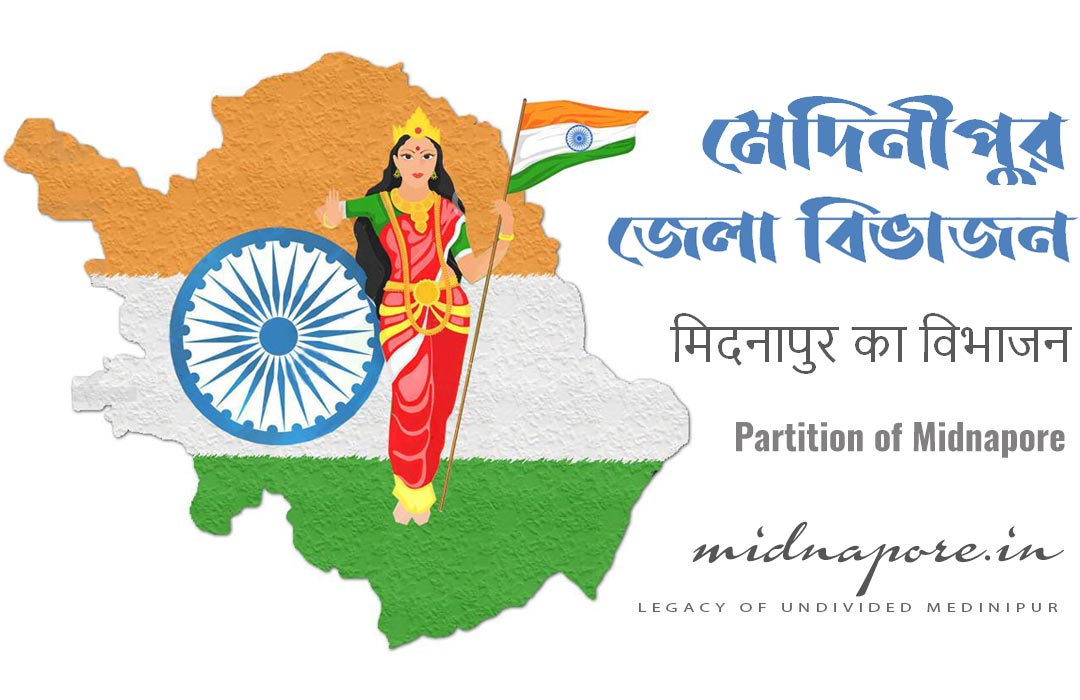

অরিন্দম ভৌমিক।
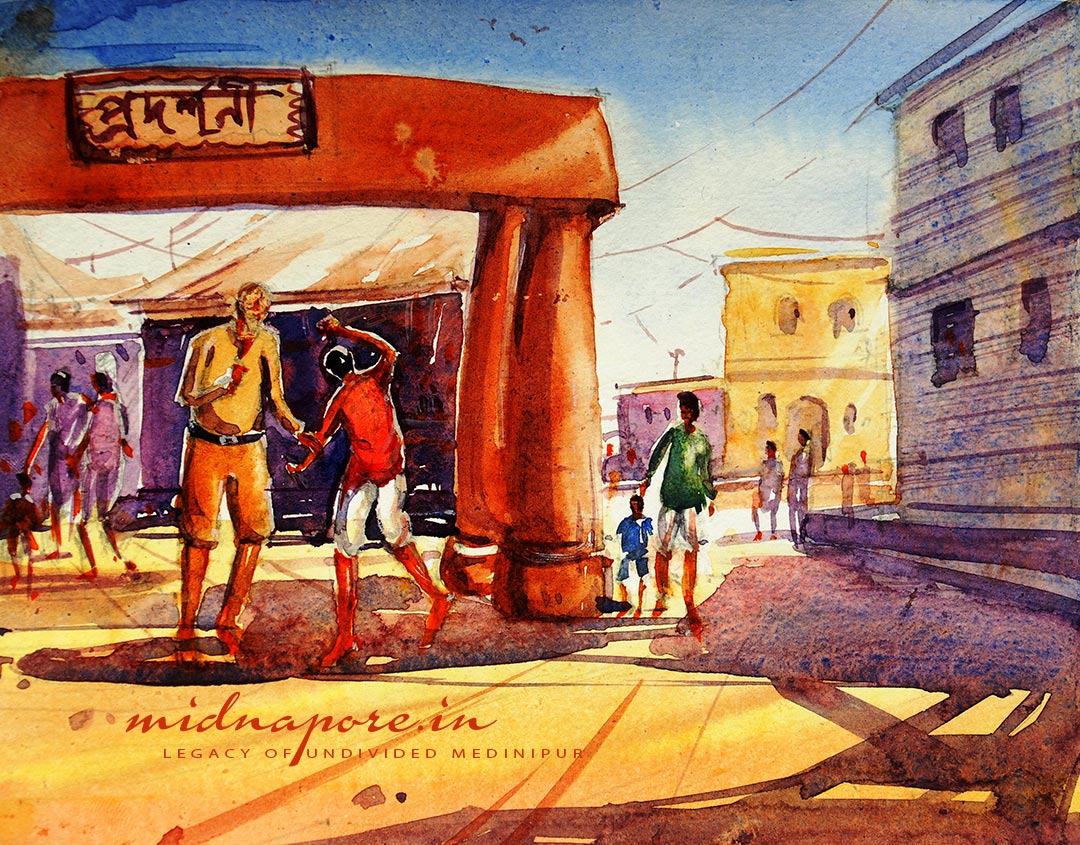
প্রদর্শনীর গেটের বাইরে কনস্টেবল ও ক্ষুদিরাম বসু। চিত্রঃ "কে ক্ষুদিরাম" বই থেকে সংগৃহিত।
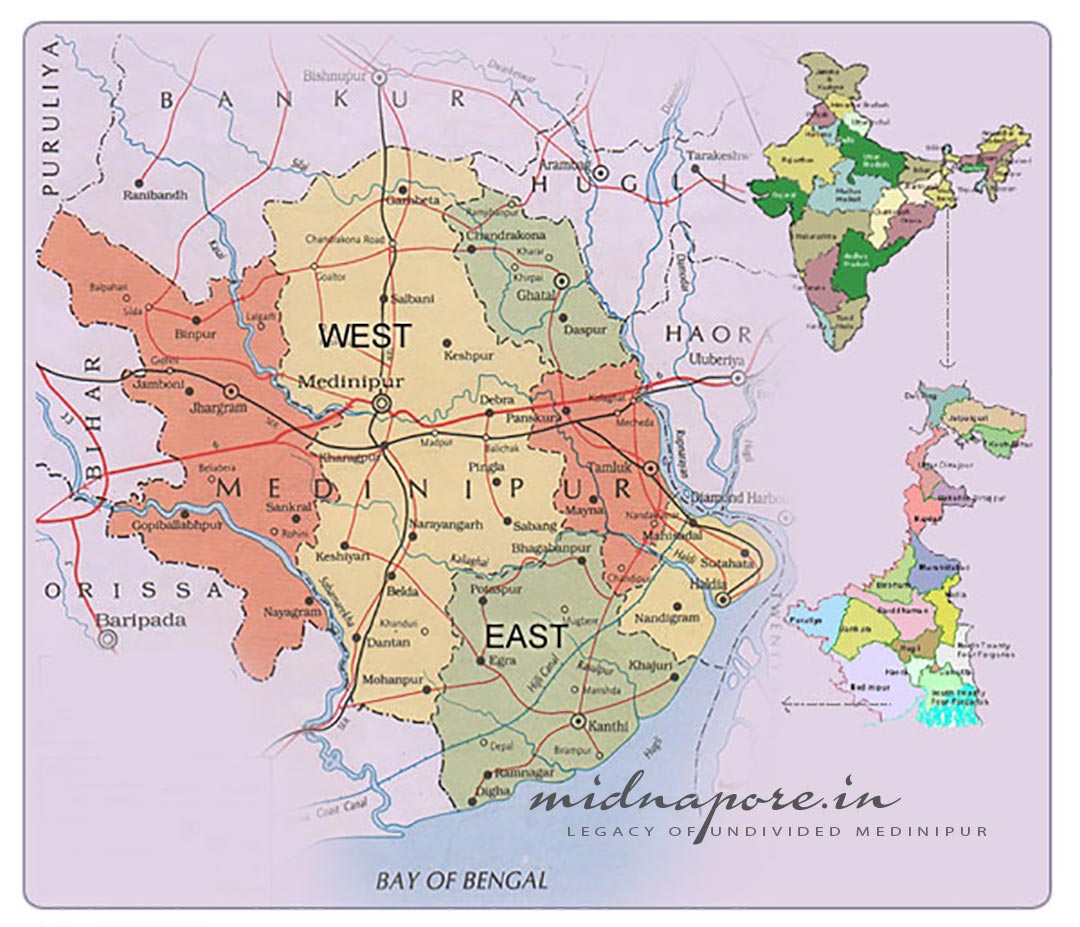
অবিভক্ত মেদিনীপুর জেলার মানচিত্র। চিত্রঃ মিডনাপুর-ডট-ইন ওয়েবসাইট থেকে সংগৃহিত।

জেলা বিভাজনের পরে পূর্ব ও পশ্চিম মেদিনীপুর।
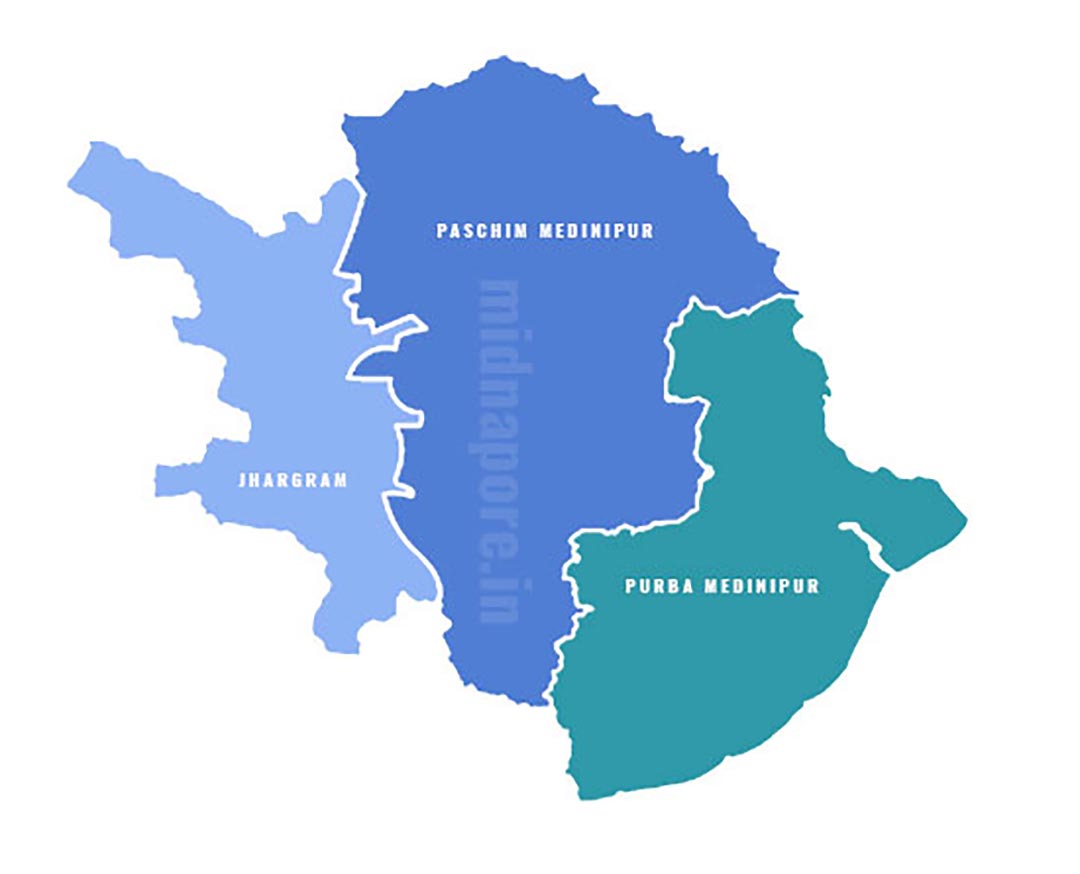
জেলা বিভাজনের পরে ঝাড়গ্রাম,পূর্ব মেদিনীপুর ও পশ্চিম মেদিনীপুর। চিত্রঃ মিডনাপুর-ডট-ইন ওয়েবসাইট থেকে সংগৃহিত।
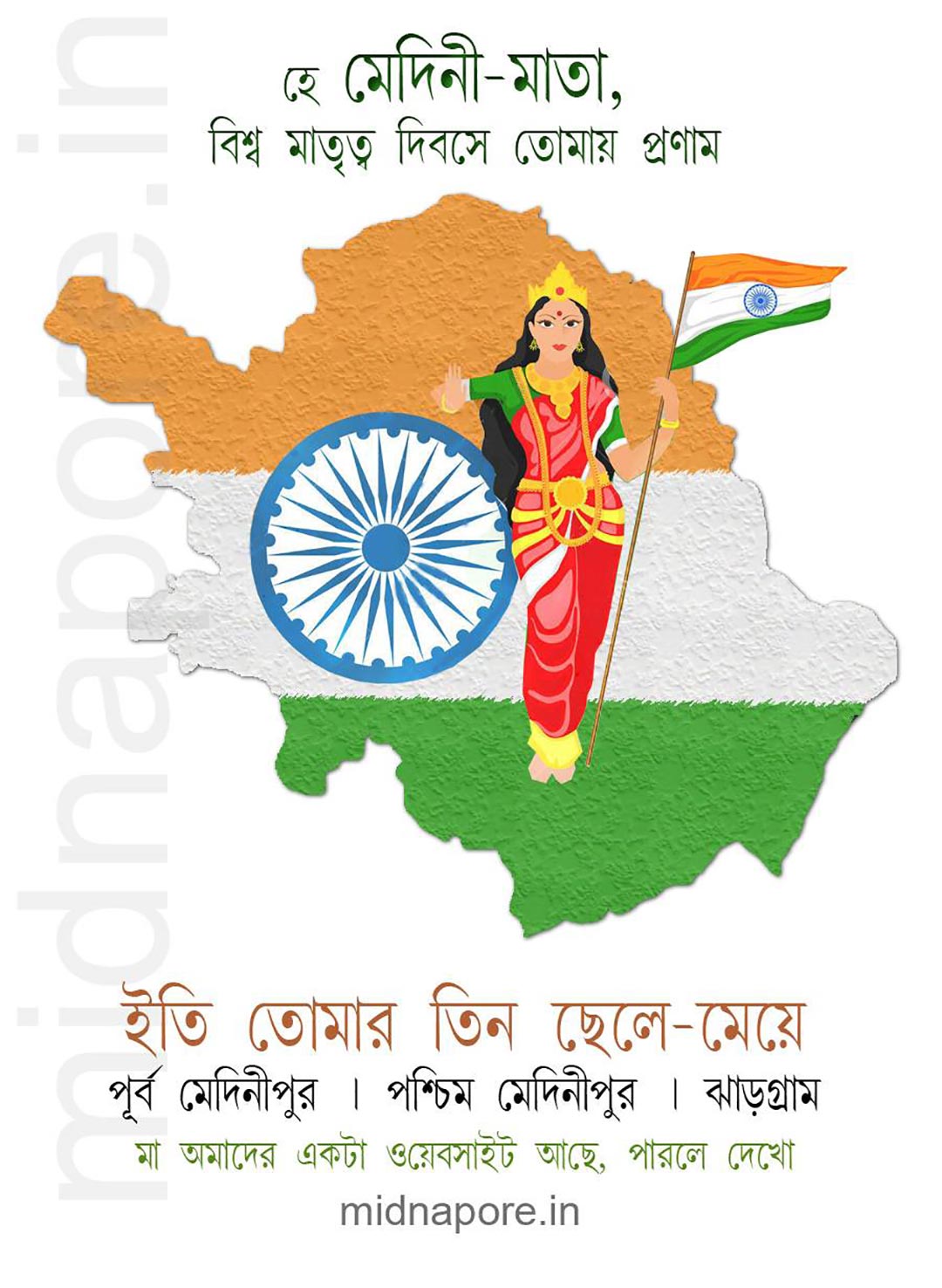
চিত্রটি বিশ্ব মাতৃত্ব দিবসে মিডনাপুর-ডট-ইন কর্তৃক সোশ্যাল মিডিয়ায় পোস্ট করা হয়েছিল।
Arindam Bhowmik
Year 1906, Medinipur was the major center of the revolutionary movement at that time. The Swadeshi movement and the Gupta Samiti were getting stronger in Medinipur. In February, an agricultural and industrial exhibition was organized at the old jail premises (now vagrant residence) of the Maratha fort in Medinipur town. A ceremony was held inside the jail at the end of the exhibition to distribute prizes and testimonials. The boys of the collegiate school were volunteering and Ramcharanbabu was managing them. The function was attended by Magistrates, District Judges, Police Officers, government and non-government dignitaries. The event was so crowded that there was no room for anyone to entertain as there were various arrangements for poetry-song, puppet-dance etc. for the entertainment of all. Many people came to the gate of the prison to enter.
While District Magistrate D. Weston was handing out prizes and testimonials, Khudiram was standing at the gate of the jail handing out a pamphlet called 'Sonar Bangla' to everyone for free. Khudiram was given this responsibility from Medinipur-Gupta Samiti. The pamphlet contained various provocative statements against the oppressive rulers, even to the point of killing them.

Constable and Khudiram Basu outside the gate of the exhibition. Image: Collected from the book "Ke Khudiram?".
Upon receiving the complaint, the police constable came and arrested Khudiram. Everything was fine until the constable was trying to snatch those leaflets. Khudiram lost his temper and started randomly punching the constable in the nose and face. As a result, a lot of blood started coming out of the nose of Constable Ramlal Upadhyay. Despite the blood, the huge-faced constable did not let go of Khudiram's hand. Upon hearing the news of Khudiram's arrest, Satyendranath Bose appeared there and wisely asked the constable – “Tum Kahe deputi babuka lerkeko pakar rakha hai (Why are you arresting Deputy Babu's son?)?” Satyendranath Bose was then working in the Collectorate office and was known to Constable Ramlal Upadhyay. Hearing Satyendranath Basu's words, the constable got scared and immediately released Khudiram. Khudiram got away and fled with the leaflets in an instant. After a while, Constable Ramlal realized his mistake and gathered other constables to look for Khudiram. But after much searching, Khudiram could not be found. Khudiram later surrendered and the case went ahead. After losing the case due to lack of sufficient evidence, the government side was forced to release Khudiram.
In 1907, that is, the following year, the Agriculture and Industrial Fair was organized again in the same place. In protest, volunteer students led by Satyendranath Bose (Khudiram Bose was also in the group) boycotted the fair. Most of the exhibitors responded to their calls and left with their own content. The editor of Medinibandhab also wrote about the boycott of the fair.
Seeing the deplorable condition of the fair, the rulers brought the Minerva Theater to attract the masses. Mr Weston and District Judge Darbal were forced to leave the fair when students entered the fair chanting "Bandemataram" after the badge. Mr Weston and District Judge Darbal were forced to leave the fair when students entered the fair chanting "Bandemataram" wearing the badge. Police started using random sticks to disperse the students. The harder the stick hit the body, the louder the boys shouted "Bandemataram".
On December 6 of the same year, the revolutionaries tried to assassinate Governor Fuller by detonating an explosion on the railway line near Narayangarh station in Medinipur. Fuller survived fortunately.
The next day the Medinipur district state conference was held. The conference was attended by state leaders like Surendranath Bandopadhyay and Arabinda Ghosh.
In the evening of the day after the state conference (December 7), a public meeting of the extremists was held on the bank of the Chandrakar pond. This was the first public meeting of extremists in the country.
This was the situation of Medinipur town. The movement spread to different parts of the district. As the days go by, the activities of Swadeshi Andolan and Gupta Samiti have been increasing. Disappointed, District Magistrate Mr. Weston and District Judge Darbal approached Burdwan Divisional Commissioner Mr. Hare. On the advice of Sir Andrew Fraser, Mr. Hare decided that in order to control the revolt of such a large district, the district must be divided into two parts. In the same year, Mr. Hare visited Medinipur and announced at the civic reception that "it is certain that Medinipur will be divided into two parts and this decision will be implemented soon." Everyone is told that this division is taking place for administrative convenience.

Map of undivided Midnapore district. Image: Collected from 'midnapore.in' website.
Decision is made; Kharagpur will be the second district headquarters. 8000 bighas of land were bought near Khargpur in Hijli. A total of Rs 6 lakh was sanctioned for the new district at a cost of Rs 1.5 lakh per annum.
Medinipur roared in protest of this decision. Despite fierce opposition, the government is determined to divide the district. At that time, a case was pending against the Medinipur Zamindar Company in Jangalmahal over some rights. With the victory of general people in the end of the case, the confidence of the people and the strength to stand up against injustice was established on a firm foundation. In the end, the English government backed down. The division of the district was postponed.
When the British were in danger in 1913 before the start of the First World War, Gandhiji called everyone to help British. Many young men from Medinipur joined the war. Meanwhile, under the India Defense Act (March, 1013), the government arrested the revolutionaries in different police stations. In the absence of an active revolution, a revised draft was recommended in 1913 on the recommendation of the "Bengal Administrative Committee".
But in both cases the District and Sessions Judge's Court will remain in Medinipur. The final plan was published in January 2015. There was a storm of protest in Medinipur. Upendranath Maiti, President, Medinipur Bar Association, said about the decision - "This proposal is unrealistic from an economic point of view; rather, it is the immediate duty of the district administration to take appropriate measures to revive the district's economy." Prominent nationalist barrister and politician Birendranath Shasmal and a few other delegates made deputations to Governor. He said that Medinipur should not be divided. Medinipur wants to maintain its tradition of diversity and vastness. But the government did not care the words of the district people. The construction work of Hijli office house started.
Seeing the situation, the pace of the movement was diverted. It was claimed that if it was the second district, its headquarters would be in Contai (Kanthi). Birendranath wrote articles. Public opinion became turbulent. Governor Lord Carmichael visited Kanthi. He was given a memorandum. Several members of the Indian National Congress opposed the Government district. They felt that the ruling class was trying to destroy the political unity of the undivided district. Already Mrs. Anne Besant started the Home Rule movement in 1918. All the moderates and extremists including Deshbandhu Chittaranjan joined the Home Rule movement. Medinipur was agitated by this movement; Home Rule movement lasted till 1917. Even after that, the people of Midnapore continued to oppose the district-division proposal till 1921. Finally, in 1921, the British government completely cancelled the plan.

East and West Midnapore after division of districts.
India became independent on 15 August 1947. In independent India, the government has repeatedly expressed its desire to divide the Midnapore district, but it has not materialized. Finally, Chief Minister Buddhadeb Bhattacharya finalized the outline of the district. After 55 years of independence, Medinipur district was divided into two parts to facilitate administrative work. The day was January 1, 2002. Medinipur district was divided into two districts, East Midnapore and West Midnapore. Before the division of the district, the population of Medinipur was 98 lakhs. The district was the largest in India in terms of area. Many countries, including Sweden, had smaller populations than undivided Medinipur. Midnapore Sadar, Kharagpur, Jhargram and Ghatal are the four subdivisions of West Midnapore district. The town of Medinipur became the headquarters of this district. On the other hand, Tamluk, Kanthi, Egra and Haldia are the three subdivisions of East Medinipur district. Tamluk (Kanthi subdivision was broken up into Egra subdivision) to become the headquarters (head office) of the district.

After the division of the district - Jhargram, East Midnapore and West Midnapore. Image: Collected from midnapore.in website.
Fifteen years after the division of Medinipur, West Midnapore was again divided. On April 4, 2016, after 70 years of independence, Jhargram, the 22nd district of West Bengal, was formed. This new district consists of Jhargram subdivision of West Midnapore district. Jhargram city has got the status of Sadar city (head office) of this district consisting of 6 blocks.

The image was posted on social media by "midnapore.in" on World Mother's Day.
midnapore.in
তথ্যসূত্র:-
● Ke Khudiram ? by Arindam Bhowmik, ISBN 978-81-931892-4-5
● History of Midnapore, Narendra Nath Das
● মেদিনীকথা - পূর্ব মেদিনীপুর, পর্যটন ও পুরাকীর্তি, অরিন্দম ভৌমিক(Arindam’s, ২৯ আষাঢ় ১৮২৩)।
● HUNTER, W.W. (1997) A Statistical Accounts of Bengal.
● O’MALLEY, L.S.S. (1911) Bengal District Gazetteers, Midnapore.
● PRICE, J.C. (1876) Notes on the History of Midnapore, as contained in records extant in the collector’s office.